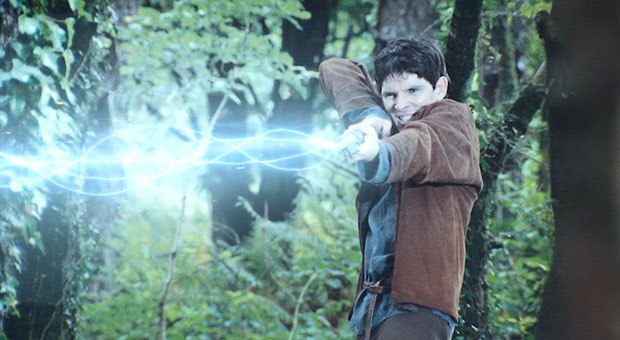Find out what tricks The Mill provided for the new Merlin series.
While viewers are just getting acquainted with NBC's import of season one of Merlin, the Mill of London is hard at work on vfx for season two, which airs Sept. 4 on BBC One. Loosely based on the Arthurian legends of the mythical wizard Merlin and his relationship with Prince Arthur, the series is highly influenced by Smallville and is an origin story before the golden age of Camelot where magic is banned and Merlin is a young servant to Arthur who has to hide his abilities.
From magical tornados that enable witches to make their getaway in the very first episode to magical mists that rot fruit, Merlin's eye magic, the fire that the dragon breathes to create Excalibur, daggers that fly through the air in slow motion that are almost impossible to shoot with differing film speeds for the live action that help to tell the story of "Merlin time" character transformations, there is a marvelous mix of requirements from the stories, according to The Mill.
"We believe that the best thing for any production, wherever possible, is to shoot real practical elements, which can then be composited with the live action and revert to 3D when this is not possible," explains Rebecca Johnson, The Mill's visual effects producer. "Even then, it is great to have real elements so wherever possible we work in tandem with other departments to create shots: the fireballs in episode 13 are a good example. Practical elements for real fireballs prepared by Colin Gory were shot against black from the correct angles and were composited with the live action after the edit back at The Mill."
Adds Will Cohen, the visual effects supervisor, "Within the context of several episodes we have had to create matte painted backgrounds using photographs and real elements, where possible, to create mountains and snowy peaks where there aren't any to help set the scene and tell the stories through enhancing the geography, such as mountains [in an upcoming episode of season two].
"We have also helped enhance views of Camelot, building a town next to the battlements of Pierrfond (the French medieval castle that is the real location for Camelot) and adding flags to the battlements, in both the daytime and at night. We built some 3D geometry for the environment that helps us line up the correct camera angle with the geometry and paint on top of that. It also enables us to track Camelot set extensions to simple camera moves as the paintings become 2.5D rather than merely 2D lock offs."
Other set extensions in the course of the series have included tournaments in the Camelot grounds where the production team has built a partial set, such as one stadium block for the crowd and The Mill has painted in the rest. And, of course, the dragon's cave is mainly a set of matte paintings. Colin Morgan, who plays Merlin, is shot on a small piece of cave set against greenscreen using mix and overlay to line up the camera with pre-existing angles for the environment and The Mill paint in the rest of the frame.
But it is the dragon (voiced by John Hurt) that is the mainstay of the series. "When [series creators] Johnny [Capps] and Julian [Murphy] first asked us if we could create a CG returnable character in nearly every episode that would talk, we were extremely excited as we knew it would be the perfect vehicle for our in-house facial tracking software (Ruth) that we had spent a couple of years developing," suggests Johnson. "Whilst we rely on shooting John Hurt's performance in the sound studio, using beads on his face to enable us to track his movements, we have developed a system that successfully captures and transfers 98% of his performance on to the model. Animators then start to enhance the performance over the top of the base layer of John's performance and add back in eye blinks. It is a pretty robust pipeline and I am not sure anyone else has done something like this for television before."
Another challenging creature was the griffon (a crow's head on top of a black panther). "We had to do a little feather solution for that," Cohen says. "It involved some R&D for what I call a half-feather solution. When we have another project that has to do with feathers, we can take it the rest of the way."
The general challenge is that there are few reusable assets from week to week (the studio uses a Maya pipeline). They started building assets for the first season in February 2008, and filming began in March. But once The Mill received plates, it had only five months to finish the job. And this season's schedule may turn out to be tighter with the episodes being shot out of sequence.
Season two will certainly have its share of fantasy creatures following season one's spiders, griffon, cockatrice, fairies from Avalon and questing beast (a combination of eagle and lion). However, Johnson says the majority of the new creatures will be less fanciful such as a giant scorpion and boor.
"We really hope having had the experience of making the first [season] we have been able to learn lessons with the production team and up the ante with regard to scale, interaction and how the creature plates are shot," Cohen offers. "One of the changes for this [season] has been the creation of a giant ruler on set to help directors and the DOP frame up for size and focus. I think one of the big lessons that the production team learned is how to be clever about how you view the creatures. You don't have to see every part of them every time. We try and treat them more as if they're really there rather than how to frame them."
Bill Desowitz is senior editor of AWN and VFXWorld.










